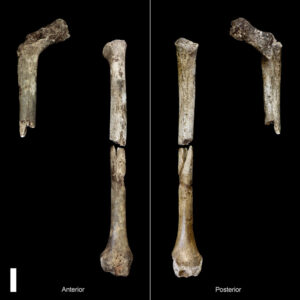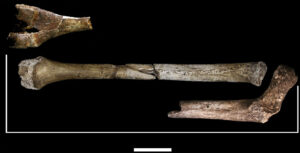Decoding a New Addition to the Human Family Tree

The bones are dishwater gray, specked with clay-like muck that stuck long, long ago.
Some have long cracks; many are incomplete. They are tiny and slender and look as though they could easily snap in half.
They look unsubstantial, but they say so much.
For Christopher Walker, assistant professor of anatomy at the NC State College of Veterinary Medicine, looking at a femur reveals that the newly discovered hominin species named Homo naledi likely walked upright. As a whole, the bones provide important clues on movement, body mass and height.
With Walker’s help, H. naledi will add a new chapter to the story of how we moved from our ancient ancestors to the Homo sapiens we are today.
Discovered in 2013, H. naledi is intriguing and perplexing. The size of its brain is only marginally larger than a chimpanzee, about the size of an orange, but the shape of its skull is more human than ape. Its shoulder and finger bones suggest climbing abilities, a trait in line with primitive human ancestors.
But the skeletal evidence of walking upright and hands that suggest the ability to manipulate objects are reflective of more recent human relatives, such as Neanderthals and Homo erectus.
It’s all a mystery and for years the subject of heated debate. But a lot of what we will eventually know for sure about H. naledi, we will know because of what its bones tell Walker.
“There’s nothing quite like it in the hominin fossil record,” said Walker. “As far as what that means, I don’t know. We’re still working on that.”
An evolutionary twist
Two H. naledi research papers, published in the journal eLife, one co-authored by Walker, answer some questions and raise more.
The biggest surprise is the age of the H. naledi specimens uncovered so far, the subject of the first paper. When it was originally discovered, some researchers estimated it could be 2 million years old, placing the specimens in the same time frame as ape-like australopithecines.
Following the use of six independent dating methods, the original H. naledi bones, discovered in the Dinaledi Chamber of the Rising Star cave system near Johannesburg, South Africa, are now estimated to be between 335,000 and 236,000 years old. If that date holds, these particular specimens were living around the same time that Homo sapiens were rising in Africa and other, large-bodied and large-brained modern human cousins were thriving in Europe and Asia.

The second paper announces the discovery of more H. naledi bones in another section of the cave system. So far, more than 130 hominin specimens have been uncovered in the Lesedi Chamber, adding to the 1,500 specimens from 15 individuals already uncovered in the Dinaledi Chamber — a rarely massive haul of hominin fossils. And the Lesedi specimens look remarkably similar to the Dinaledi specimens. (Taken from the Setswana language of South Africa, “Lesedi” means “light.” “Naledi” means “star” in the Sesotho language and “Dinaledi” means “stars”).
Everything leads to more questions that will take years or decades to answer — if they are answered at all.
How long ago did H. naledi originate and how, if at all, does it factor into the evolution of modern humans? Why did H. naledi retain its primitive features as, at perhaps the same time, bigger-brained H. sapiens refined their modern characteristics? Did H. naledi make advanced stone tools? Did they live side-by-side in southern Africa with other hominin species? Did humans drive them to extinction?
And how did they get into that cave to begin with?
Researchers with the project have hypothesized that the Rising Star individuals may have been deliberately disposed of in the cave, in part because of their hard-to-reach resting places as well as lack of other material in the cave, like animal bones. Perhaps H. naledi threw family members into the cave since their rotting bodies were attracting predators.
The “deliberate disposal” hypothesis has sparked spirited debate for years; researchers didn’t expressly say it represented intelligent burials, but others have taken it that way. And that’s not the only controversy.
The findings are ambiguous — and, to Walker, thrilling.
“With Homo naledi, we’ve added nearly 2,000 fossils for this species alone and in a way we know less about human evolution than we did before,” said Walker. “For every new fossil, there are often new questions that go along with it.”
“But that’s exciting, too. That’s what science is. Science is discovery. Science is working towards a right answer — and not always achieving the right answer.”
But Walker’s work with the project has potential to definitively answer a number of questions. His involvement is akin to what he does at the CVM: comparative anatomy. In this case, he just happens to be investigating the anatomy of humankind’s ancestors as opposed to the anatomy of cats, dogs and horses.
After H. naledi was first discovered, Walker was part of a team looking at both the lower and upper limb material and counting the number of individuals in the assemblage. With the Lesedi Chamber specimens, he is doing much of the same work, but paying particular attention to H. naledi’s femur. There are just three of them from Lesedi, but they preserve areas of anatomy not present in the dozens of femora uncovered in the Dinaledi Chamber.
For the next few years, Walker will be virtually analyzing, bone by bone, the remains found in both chambers by looking through CT and surface scans. His CVM office is a one-man digital anatomy lab. While others on campus have labs full of microscopes and pipettes, Walker works with high-powered computers, 3-D printers and 3-D scanners.
“My role for the past couple years has been describing the bones and saying how they’re similar and how they’re different from other hominin specimens,” said Walker. “And just now are we really starting to look at what that all means.”
An unexpected career
You can thank a rude fellow student for Walker’s interest in biological anthropology. While at the University of California at San Diego, he couldn’t hear something a professor said in a large pre-med biology lecture. He leaned over to the person to his left and asked for what he missed. The student scowled at him, covered his notes and looked away. Walker attributed that behavior to the competitive nature of the track, perhaps leading to students who were a bit unwilling to help other students.
He found the experience so off-putting that he opened a majors catalog and scanned for something else. He discovered that he could major in biological anthropology and still be able to apply to medical school if he wanted.
He wouldn’t need the option. The first few classes on skeletal biology, forensic anthropology and hominin paleontology sparked an interest that soon turned into a burgeoning career path.

Walker traveled abroad at Australian National University to take advantage of more specialized courses, eventually earning a bachelor’s in biological anthropology from UCSD. From there, it was off to the University of Cambridge where he received a master’s in biological anthropological science. While there, Walker worked on a project with modern humans and chimpanzees, looking at the development of limb bones.
He had no intention of delving in paleontology. Instead, he applied to graduate school at Duke University expecting to conduct research similar to what he had done at Cambridge. His eventual adviser at Duke, Steven Churchill, was known for doing similar work. Little did Walker know that he was brought in because Churchill was analyzing recently found fossils of Australopithecus sediba, found in 2008 in Malapa cave, near where H. naledi would be discovered. He had enlisted Walker to help.
”I didn’t know what to think at first,” said Walker. “I had never held a hominin fossil in my hand and yet I recognized that it was an immense opportunity. A first-year Ph.D. student does not often get this sort of access to such a major find.”
Working on A. sediba, dated to about 2 million years ago, set Walker on a direct path to work on H. naledi.
A. sediba was discovered by American-born paleoanthropologist Lee Berger, who is based at the University of the Witwatersrand in Johannesburg, and his son, Matthew, just 9 years old at the time. Walker went to South Africa to meet Berger while studying A. sediba.
As Berger, a National Geographic explorer-in-residence, led the team uncovering H. naledi and as he began sorting the 1,500 specimens, he assigned core groups to analyze various parts of the finds. Walker said he will never forget the first time he saw the H. naledi fossils.
“I saw a tibia, a juvenile tibia. It has the charismatic name U.W. 101-1070,” said Walker. “It was so slender. It was so gracile. I thought, ‘How did this thing walk without crumbling under its own weight?’
“That’s when I realized that this was going to be a wild ride with Homo naledi.”
Walker’s anatomy
The publication of the newest H. naledi papers only scratches the cave’s surface. Analysis of the bones will take years and researchers believe there are more specimens to be found in the cave. Importantly, the finds from the Lesedi Chamber still need to be dated.
And one guy from Lesedi is particularly remarkable. Many of the Lesedi specimens uncovered so far look like parts of one individual: an adult male the team has named “Neo,” which means “gift” in Sesotho.
[pullquote color=”orange”]“Working with the vet students and teaching the anatomy of a number of different species has changed my approach to research. It has changed my way of thinking.” [/pullquote]Neo’s skull, a bit larger than the ones found in Dinaledi, is nearly complete, an extreme rarity in hominin finds. There are parts of arms, ribs, wrists, legs, hands and spine. Its teeth show wear, indicating an older individual.
Walker is very familiar with H. naledi’s teeth — he’s working on a project looking at the hominin’s dental development. This summer, he will be looking more closely at the biomechanics of the H. naledi lower limb, working virtually with colleagues in the U.S. and abroad.
He also works on projects with his wife, Kara Walker, a chimpanzee behavioral ecologist and postdoctoral associate in evolutionary anthropology at Duke University. The pair met while at grad school at Duke. One of their projects is studying developmental milestones in chimpanzees to better understand the evolution of human aging.
And now, and for years to come, he will study the thousands of found H. naledi bones and those that may be found in the future. But he’s also preparing to teach anatomy in the fall to the next class of budding veterinarians at the CVM. And, to him, that’s just as important to contributing to humankind’s widening family tree.
“The most impactful moment for me as a professional has been coming to the CVM,” said Walker. “Working with the vet students and teaching the anatomy of a number of different species has changed my approach to research. It has changed my way of thinking.”
~Jordan Bartel/NC State Veterinary Medicine


